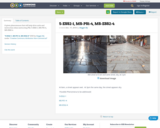
A given phenomenon that will help drive units and instruction when instructing PEs: 5-ESS2-1, MS-PS1-4, MS-ESS2-4
- Subject:
- Applied Science
- Environmental Science
- Physical Science
- Material Type:
- Teaching/Learning Strategy
- Date Added:
- 12/14/2018

A given phenomenon that will help drive units and instruction when instructing PEs: 5-ESS2-1, MS-PS1-4, MS-ESS2-4
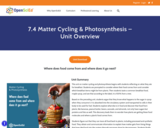
This unit on matter cycling and photosynthesis begins with students reflecting on what they ate for breakfast. Students are prompted to consider where their food comes from and consider which breakfast items might be from plants. Then students taste a common breakfast food, maple syrup, and see that according to the label, it is 100% from a tree.
Based on the preceding unit, students argue that they know what happens to the sugar in syrup when they consume it. It is absorbed into the circulatory system and transported to cells in their body to be used for fuel. Students explore what else is in food and discover that food from plants, like bananas, peanut butter, beans, avocado, and almonds, not only have sugars but proteins and fats as well. This discovery leads them to wonder how plants are getting these food molecules and where a plant’s food comes from.
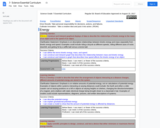
7th Grade Regular Science Scope & Sequence
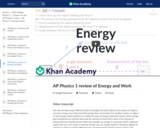
In this video David explains the concepts in Work and Energy and does an example problem for each concept. Link for document: https://www.dropbox.com/s/t1w6xlnkozzel17/Energy%20review.pdf?dl=0. Created by David SantoPietro.
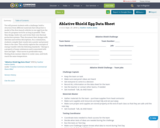
You will present students with a challenge: build a structure from different materials that will protect a model of the Ares launch vehicles (a raw egg) from the heat of a propane torch for as long as possible. Then they design, build, test, and revise their own thermal protection systems. They document their designs with sketches and written descriptions. As a culmination, students compile their results into a poster and present them to the class.
This activity explores the concepts of energy transfer with the following standards:
• Energy is a property of many substances and is associated with heat and light.
• Heat moves in predictable ways, flowing from warmer objects to cooler ones, until both reach the same temperature.

This segment from Swift: Eyes through Time traces the history military officers and engineers discovering a strange phenomenon in the sky that astronomers now know are gamma-ray bursts.
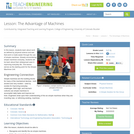
In this lesson, students learn about work as defined by physical science and see that work is made easier through the use of simple machines. Already encountering simple machines everyday, students will be alerted to their widespread uses in everyday life. This lesson serves as the starting point for the Simple Machines Unit.
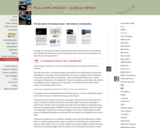
This book is written for anybody who is curious about nature and motion. Curiosity about how people, animals, things, images and space move leads to many adventures. This volume presents the best of them in the domain of everyday life.
Carefully observing everyday motion allows us to deduce six essential statements: everyday motion is continuous, conserved, relative, reversible, mirror-invariant – and lazy. Yes, nature is indeed lazy: in every motion, it minimizes change. This text explores how these six results are deduced and how they fit with all those observations that seem to contradict them. In the structure of modern physics, shown in Figure 1, the results on everyday motion form the major part of the starting point at the bottom. The present volume is the first of a six-volume overview of physics. It resulted from a threefold aim I have pursued since 1990: to present motion in a way that is simple, up to date and captivating.
In order to be simple, the text focuses on concepts, while keeping mathematics to the necessary minimum. Understanding the concepts of physics is given precedence over using formulae in calculations. The whole text is within the reach of an undergraduate.
In order to be up to date, the text is enriched by the many gems – both theoretical and empirical – that are scattered throughout the scientific literature.
In order to be captivating, the text tries to startle the reader as much as possible. Reading a book on general physics should be like going to a magic show. We watch, we are astonished, we do not believe our eyes, we think, and finally we understand the trick. When we look at nature, we often have the same experience. Indeed, every page presents at least one surprise or provocation for the reader to think about. Numerous interesting challenges are proposed.
The motto of the text, die Menschen stärken, die Sachen klären, a famous statement by Hartmut von Hentig on pedagogy, translates as: ‘To fortify people, to clarify things.’ Clarifying things – and adhering only to the truth – requires courage, as changing the habits of thought produces fear, often hidden by anger. But by overcoming our fears we grow in strength. And we experience intense and beautiful emotions. All great adventures in life allow this, and exploring motion is one of them. Enjoy it!

This book is written for anybody who is curious about nature and motion. Curiosity about how people, animals, things, images and empty space move leads to many adven- tures. This volume presents the best of them in the domains of relativity and cosmology. In the study of motion – physics – special and general relativity form two important building blocks.
Special relativity is the exploration of the energy speed limit c. General relativity is the exploration of the force limit c4/4G. The text shows that in both domains, all equations follow from these two limit values. This simple, intuitive and unusual way of learning relativity should reward the curiosity of every reader – whether student or professional.
The present volume is the second of a six-volume overview of physics that arose from a threefold aim that I have pursued since 1990: to present motion in a way that is simple, up to date and captivating.
In order to be simple, the text focuses on concepts, while keeping mathematics to the necessary minimum. Understanding the concepts of physics is given precedence over using formulae in calculations. The whole text is within the reach of an undergraduate.
In order to be up to date, the text is enriched by the many gems – both theoretical and empirical – that are scattered throughout the scientific literature.
In order to be captivating, the text tries to startle the reader as much as possible. Read- ing a book on general physics should be like going to a magic show. We watch, we are astonished, we do not believe our eyes, we think, and finally we understand the trick. When we look at nature, we often have the same experience. Indeed, every page presents at least one surprise or provocation for the reader to think about. Numerous interesting challenges are proposed.
The motto of the text, die Menschen stärken, die Sachen klären, a famous statement by Hartmut von Hentig on pedagogy, translates as: ‘To fortify people, to clarify things.’ Clar- ifying things – and adhering only to the truth – requires courage, as changing the habits of thought produces fear, often hidden by anger. But by overcoming our fears we grow in strength. And we experience intense and beautiful emotions. All great adventures in life allow this, and exploring motion is one of them. Enjoy it!

This lesson plan engages students in a real-life exploration of climate change as it is affected by greenhouse emissions from vehicles. The aim of this activity is for students to realize the impact of vehicle use in their family and to give students the opportunity to brainstorm viable alternatives to this use.
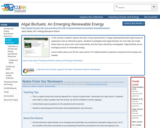
In this activity, students explore the basic living requirements of algae (phytoplankton)through hands-on experience and an interactive game. Students investigate what algal biofuels are, how they are made, where they can grow, and, most importantly, why this topic should be investigated. Algal biofuels are an emerging source of renewable energy.
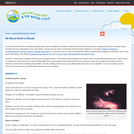
In this informational text, elementary school readers learn about the difference between weather and climate and about components of the climate system. The text can be used to practice visualizing and other comprehension strategies. Available in K-2 and 3-5 grade bands and as an illustrated book as well as a text document, the story appears in the online magazine Beyond Weather and the Water Cycle.
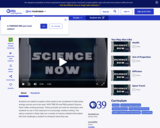
Students are asked to explain what needs to be considered if alternative energy sources are to be used. ***Access to Teacher's Domain content now requires free login to PBS Learning Media.

This activity is a debate on alternative energy sources.
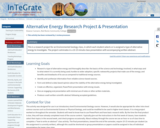
This is a research project for an Environmental Geology class, in which each student selects or is assigned a type of alternative energy to investigate. The project culminates in a 10-15 minute class presentation with accompanying written abstract.
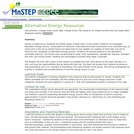
This activity is a cooperative learning experience investigating alternative energy resources.

We will explore the changing political choices and ethical dilemmas of American scientists from the atomic scientists of World War II to biologists in the present wrestling with the questions raised by cloning and other biotechnologies. As well as asking how we would behave if confronted with the same choices, we will try to understand the choices scientists have made by seeing them in their historical and political contexts. Some of the topics covered include: the original development of nuclear weapons and the bombing of Hiroshima and Nagasaki; the effects of the Cold War on American science; the space shuttle disasters; debates on the use of nuclear power, wind power, and biofuels; abuse of human subjects in psychological and other experiments; deliberations on genetically modified food, the human genome project, human cloning, embryonic stem cell research; and the ethics of archaeological science in light of controversies over museum collections.
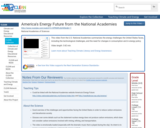
This video from the U.S. National Academies summarizes the energy challenges the United States faces, including the technological challenges, and the need for changes in consumption and in energy policy.

Students design, build and test model roller coasters using foam tubing. The design process integrates energy concepts as they test and evaluate designs that address the task as an engineer would. The goal is for students to understand the basics of engineering design associated with kinetic and potential energy to build an optimal roller coaster. The marble starts with potential energy that is converted to kinetic energy as it moves along the track. The diameter of the loops that the marble traverses without falling out depends on the kinetic energy obtained by the marble.

This course focuses on alternative ways in which the issues of growth, restructuring, innovation, knowledge, learning, and accounting and measurements can be examined, covering both industrialized and emerging countries. We give special emphasis to recent transformations in regional economies throughout the world and to the implications these changes have for the theories and research methods used in spatial economic analyses. Readings will relate mainly to the United States, but we cover pertinent material on foreign countries in lectures.